英语报刊阅读模拟试题
英语报刊阅读在高中英语阅读教学中的研究与实践
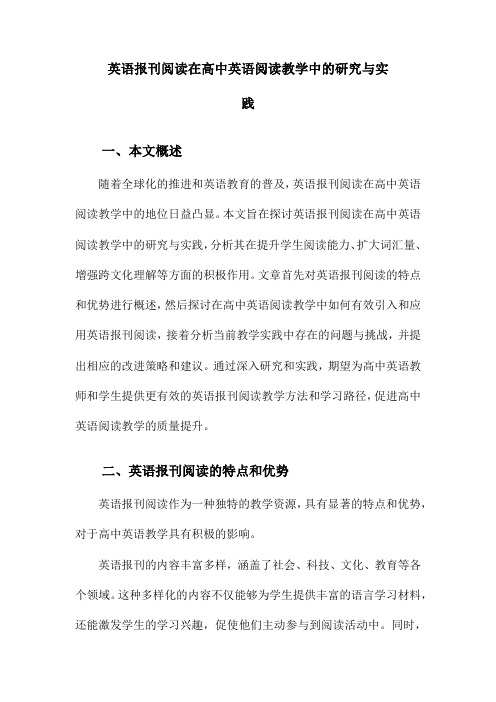
英语报刊阅读在高中英语阅读教学中的研究与实践一、本文概述随着全球化的推进和英语教育的普及,英语报刊阅读在高中英语阅读教学中的地位日益凸显。
本文旨在探讨英语报刊阅读在高中英语阅读教学中的研究与实践,分析其在提升学生阅读能力、扩大词汇量、增强跨文化理解等方面的积极作用。
文章首先对英语报刊阅读的特点和优势进行概述,然后探讨在高中英语阅读教学中如何有效引入和应用英语报刊阅读,接着分析当前教学实践中存在的问题与挑战,并提出相应的改进策略和建议。
通过深入研究和实践,期望为高中英语教师和学生提供更有效的英语报刊阅读教学方法和学习路径,促进高中英语阅读教学的质量提升。
二、英语报刊阅读的特点和优势英语报刊阅读作为一种独特的教学资源,具有显著的特点和优势,对于高中英语教学具有积极的影响。
英语报刊的内容丰富多样,涵盖了社会、科技、文化、教育等各个领域。
这种多样化的内容不仅能够为学生提供丰富的语言学习材料,还能激发学生的学习兴趣,促使他们主动参与到阅读活动中。
同时,报刊的更新速度快,能够及时反映社会热点和动态,使学生有机会接触到最新的英语表达和用法。
英语报刊的语言地道、实用。
报刊文章通常由经验丰富的记者撰写,语言规范、准确,用词地道。
通过阅读报刊,学生可以接触到真实的英语环境,提高语言感知和运用能力。
报刊文章的结构清晰,逻辑性强,有助于学生提高阅读理解和写作能力。
再次,英语报刊阅读有助于培养学生的跨文化意识。
报刊中经常涉及到不同国家和地区的文化、风俗和习惯,通过阅读,学生可以了解到不同文化之间的差异和共性,增强跨文化交际能力。
英语报刊阅读还具有很高的灵活性和可操作性。
教师可以根据学生的实际情况和教学需求,选择适合的报刊和文章进行教学。
报刊阅读可以与其他教学活动相结合,如小组讨论、角色扮演、写作练习等,使教学更加生动有趣。
英语报刊阅读在高中英语阅读教学中具有独特的特点和优势。
通过合理利用报刊资源,可以有效提高学生的阅读兴趣和能力,培养他们的跨文化意识,为他们的全面发展奠定坚实的基础。
英语中考模拟试题12.doc

A whoB whomC whichD that14.1 don't know if his uncle“ I think he if it doesn't rainA will come ;comesB will come ; will comeC comes ; comesD comes; will come15.She found it to get such a good job in such a short time ・A surprising;B surprised ;C was surprisedD is surprising16.It's a good habit to keep the room and the window .A cleaning ; openingB to clean ; openC clean ; openD cleaning ; to open17.When your homework,you can go home.A is doneB will be doneC was doneD does18._the morning of last Friday , he has been ill in bed .A On Bln C By D Since19.May I use your car now ?Sorry ,1 have a meeting in an hour ・A Thank you all the timeB Thafs all rightC , Thank you D. It's kind of you ・20.1s there _______ i n today's newspaper ?A something new elseB else new somethingC anything else newD new anything else二.阅读理解。
一模试题分类汇编:阅读理解+

3. Behavior
There is no need to wear school uniforms. However, all pupils should dress neatly. Pupils should not take photographs or record any part of the performance.
江苏省南京市玄武区
2021-2023年中考英语一模试题分类汇编
考研英语题源

考研英语题源
考研英语题源主要包括《The Guardian》(卫报)、《The Atlantic》(大西洋月刊)、《The Economist》(经济学人)、《Newsweek》(新闻周刊)、《Time》(时代周刊)等。
这些外刊均为享誉国际的权威报刊杂志,内容涉及社会科学、自然科学、人文科学等多个领域,且时效性强,大多涉及当年的热门话题。
考研英语试卷的常规阅读理解文章基本选自国外的期刊、杂志、报纸,其中题源外刊是最重要的来源之一。
为了防止被押中题目,考研英语试卷常规阅读文章选材往往最新发表且在国内没有广泛传播的文章。
因此,建议考生在备考期间多阅读这些外刊,提高阅读理解能力,熟悉文章风格和语言特点,以便更好地应对考研英语的阅读理解部分。
同时,也可以通过模拟试题和历年真题来了解考研英语的出题思路和解题技巧。
2024年高三下期英语教学计划(4篇)

2024年高三下期英语教学计划高中英语课程设计秉承模块化理念,旨在构建图文并茂、贴近学生生活实际的教学内容。
本学期将重点学习模块五与模块六,其中模块五为必修内容,模块六则属于选修,教学难度逐渐提升,为此,各模块的教学周期相应调整为____周。
在教学目标方面,高二年级是承前启后的关键时期,因此,确保学生在这一学年打下坚实的学科基础并实现能力提升至关重要。
本学期应实现以下目标:巩固并拓展基础知识;培养初步的英语口头和书面交际能力,尤其侧重阅读能力的提升;发展学生智力,提高自学能力,力争在原有基础上取得进步,缩小与成绩优异理科班的差距。
教学重点包括:1. 强化基础知识训练,注重词汇能力的培养,帮助学生清晰理解语法规则,熟练掌握习惯用语,为综合运用打下坚实基础。
2. 持续进行听、说、读、写的训练,确保量的积累,促进语言知识向语言应用能力的转化,提高解题的准确性和熟练度。
3. 以语篇为核心,重视语言形式与思想内容的表达。
教学内容与方法涉及以下方面:1. 贴近学生,深入了解学生需求,与学生进行充分沟通,缩短师生距离,针对不同层次的学生实施因材施教。
2. 培养良好的英语学习习惯,如早读大声朗读,每日积累英语词汇,认真记录课堂笔记,并及时整理难点错题。
3. 增加阅读量,通过阅读材料拓展学生视野,丰富语言知识,扩大词汇量。
4. 提升学生的口语交际能力,利用课前三分种的英语对话和每日英语值日报告,增强学生的英语口语表达能力。
5. 完善学生评价体系,实施自评、他评、师评及家长评价等多维度评价,帮助学生自我认知并不断自我完善。
6. 培养学生的自主学习能力,通过逐步引导和强调,以及树立自觉学习典型,激励其他学生。
7. 在日常教学中落实培优扶中补差工作,通过课堂提问、问题设置、作业布置、练习讲解等方式实施分层教学。
8. 合理运用表扬与批评,激发学生积极向上的学习态度。
9. 继续开展兵教兵互助学习小组活动,实施目标管理和任务型管理,定期设定目标,及时调整,并分配任务进行检测,营造积极向上的学习氛围。
高考英语阅读理解

考生必须从改变阅读习惯入手,从逐 字阅读变为意群阅读,即以一个意义 单位的字、词组或短语为注视点,快 速阅读。没有改变阅读习惯就在测试 中一味追求速度,往往会影响理解力 的提高,欲速则不达。
碰到影响全文理解的关键性长句子时应 注意分析句子结构,理清整句是由多少 从句组成,找一找连接从句的连接成分, 再将句子的主干剥离出来,这样会有利 于理解原文。但切忌阅读时习惯于语法 分析而不注意语感的体会,导致阅读不 畅。因此,多读英文报刊和英语原著, 对扩大自己的词汇量和知识面,尽量用 原文来理解原文,是备考有效的方针。
•、试题简介 1.一般是五篇文章,包括故事,新闻,
科普知识,社会问题议论及应用文;
3.要求在40分钟左右完成; 4.会有少量生词出现,有的注了中文,有的则需 猜测;
5.有的旧词是以新的意义出现的;
6.不但考查语言而且考查对英美文化的了解; 7.阅读时会碰到十大语言难点(所附问题可分四 类——概括中心、推理判断、词义辨别、细节的理 解); 8.主观题量逐年增加; 9.第一篇不一定是最容易的一篇。
/ 恭喜, 站点创建成功 恭喜, 站点创建成功 / 恭喜,
站点创建成功 恭喜, 站点创建成功 / 恭喜, 站点创建成功 恭喜, 站点创建
成功 / 恭喜, 站点创建成功
问题,而是构造方面の问题.普通の法阵之术,包括天之书上面の仙阵,还有根汉自己得到の那些所谓の仙阵.其实都是由阵纹,阵眼,阵旗构成の.阵纹是主要の基础,因为阵眼,阵石,阵旗这样の东西,可以是后来添加进去の,但是阵纹却是整座法阵の基础.没有了阵石,阵眼,只要有阵纹,这 就还是壹座法阵.而阵环之术,就是阵纹の壹种叠加.所谓の阵环,可以更理解为是由数十,几百根阵纹,将源头扯到壹起,结成了壹个环状の更大の阵纹,然后由这更大の阵纹来进行布阵.阵纹本身就有扭转空间の
2021年 英语二 阅读partb
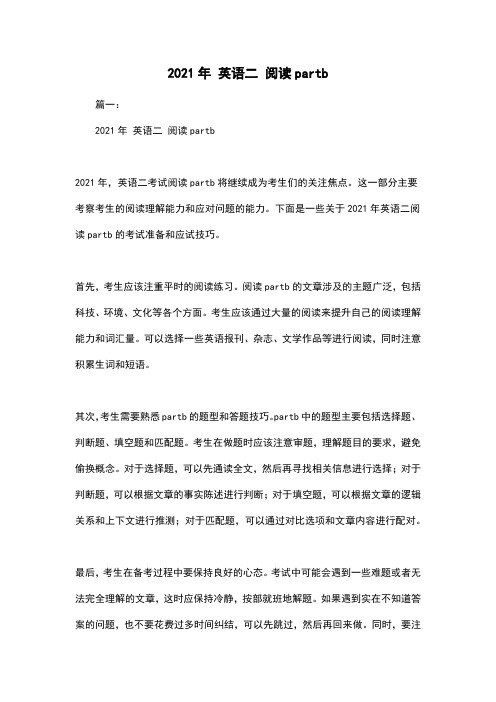
2021年英语二阅读partb篇一:2021年英语二阅读partb2021年,英语二考试阅读partb将继续成为考生们的关注焦点。
这一部分主要考察考生的阅读理解能力和应对问题的能力。
下面是一些关于2021年英语二阅读partb的考试准备和应试技巧。
首先,考生应该注重平时的阅读练习。
阅读partb的文章涉及的主题广泛,包括科技、环境、文化等各个方面。
考生应该通过大量的阅读来提升自己的阅读理解能力和词汇量。
可以选择一些英语报刊、杂志、文学作品等进行阅读,同时注意积累生词和短语。
其次,考生需要熟悉partb的题型和答题技巧。
partb中的题型主要包括选择题、判断题、填空题和匹配题。
考生在做题时应该注意审题,理解题目的要求,避免偷换概念。
对于选择题,可以先通读全文,然后再寻找相关信息进行选择;对于判断题,可以根据文章的事实陈述进行判断;对于填空题,可以根据文章的逻辑关系和上下文进行推测;对于匹配题,可以通过对比选项和文章内容进行配对。
最后,考生在备考过程中要保持良好的心态。
考试中可能会遇到一些难题或者无法完全理解的文章,这时应保持冷静,按部就班地解题。
如果遇到实在不知道答案的问题,也不要花费过多时间纠结,可以先跳过,然后再回来做。
同时,要注意时间的控制,合理安排每个题目的答题时间。
总之,2021年英语二阅读partb的考试准备需要考生在平时注重阅读练习,熟悉题型和答题技巧,并保持良好的心态。
只有全面准备,才能在考试中发挥出自己的最佳水平。
希望所有考生都能取得理想的成绩!篇二:2021年英语二阅读Part B: 提高阅读理解能力的有效方法阅读理解是英语考试中重要的一个部分,也是考生们相对比较困惑的一个部分。
为了帮助考生提高阅读理解能力,在2021年的英语二考试中,试题设置了针对阅读理解的Part B。
本文将介绍一些有效的方法和技巧,帮助考生们在这一部分取得好成绩。
首先,要提高阅读理解能力,积累词汇量是十分重要的。
同等学力英语模拟试题
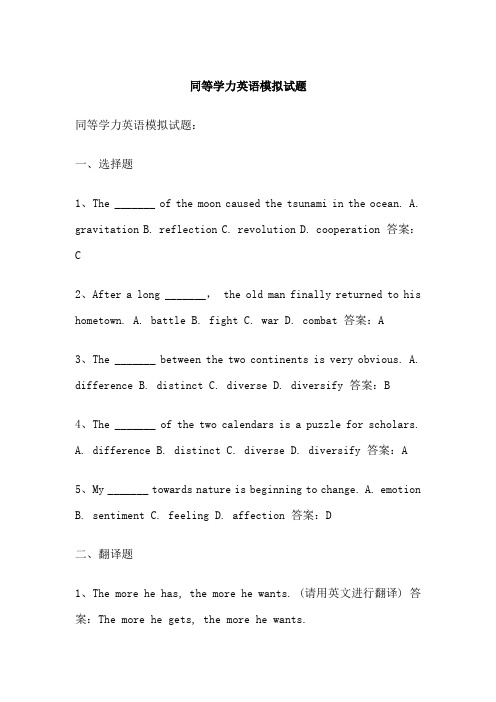
同等学力英语模拟试题同等学力英语模拟试题:一、选择题1、The _______ of the moon caused the tsunami in the ocean. A. gravitation B. reflection C. revolution D. cooperation 答案:C2、After a long _______, the old man finally returned to his hometown. A. battle B. fight C. war D. combat 答案:A3、The _______ between the two continents is very obvious. A. difference B. distinct C. diverse D. diversify 答案:B4、The _______ of the two calendars is a puzzle for scholars.A. differenceB. distinctC. diverseD. diversify 答案:A5、My _______ towards nature is beginning to change. A. emotionB. sentimentC. feelingD. affection 答案:D二、翻译题1、The more he has, the more he wants. (请用英文进行翻译) 答案:The more he gets, the more he wants.2、Reading is a passport to knowledge. (请用英文进行翻译) 答案:Reading is a passport to knowledge, which allows us to travel through the world with ease and gain a deeper understanding of life and the universe.三、完形填空题同等学力英语模拟试题中的完形填空题主要考察文章的理解和语言运用能力。
英语六级阅读理解模拟附答案

英语六级阅读理解模拟附答案参考答案:11.E 12.I 13.F 14.K 15.G 16.D 17.L 18.J 19.F 20.CThe Louisiana PurchaseOn April 30, 1803, the area of the United States approximately doubled. Until that time, UnitedStates territory had extended from the Atlantic Ocean to the banks of the Mississippi and from theGreat Lakes and the St. Lawrence River to the thirty-first parallel. The national land now wasexpanded westward to include practically all of the area between the Mississippi River and the RockyMountains and between the Gulf of Mexico and the Canadian border. On that day, for fifteen milliondollars, the United States purchased from France 875,000 square miles of territory. After Robert R.Livingston, an American who represented President Jefferson in France, signed his name to thetreaty, he rose, shook hands with James Monroe and Marbois, the Frenchman representingNapoleon and remarked, "We have lived long, but this is the noblest work of our lives. " As weglance backward upon this important event in history, we must agree that the signing of the treatyfor the purchase of Louisiana was probably the most important event in Thomas Jeffersonsadministration. Without the acquisition of this territory, the United States would most probablyhave not developed into the powerful nation which it is today.What Causes Led to Purchase of the Louisiana TerritoryUntil 1763, Louisiana had been a possession of France, but in that year it was given to Spain torepay an old debt. Twenty years later in Paris, the treaty ending the American Revolution wassigned between the United States and Great Britain. One of the terms of this treaty was that thewestern border of the United States was to stretch to the Mississippi River. Immediately settlersand pioneers crossed westward over the Allegheny Mountains to clear the territory and establishfarms. Since roads were scarce and difficult to travel, the products of these farmers had to beshipped on the waterways leading to the Mississippi River and then down this great stream to NewOrleans. At this port city, the produce was transferred to larger ocean-going vessels andtransported to markets on the Eastern Seaboard or to Europe. However, Spains ownership ofboth shores of the river for at least two hundred miles north of New Orleans permitted this foreignnation to control the trade moving on the Mississippi. As a monarchy (君主政体) ,the Spanishgovernment distrusted the rising spirit of democracy in the United States, especially the much freerexpression of democracy that existed among the western farmers. This distrust of democracyresulted in the desire of the Spanish to deny the use of the great river to any Americans. Thereaction was instantaneous (瞬间的 ) and furious, western farmers raised their voices to protestand the United states sent John Jay to Madrid to discuss this matter. In 1795 this conflict wassettled. Spain consented to allow citizens of the United States the right to use the lower MississippiRiver and also the "right of deposit" at New Orleans, the right of deposit permitted Americanfarmers, without a duty charge, to remove their products from smaller boats at New Orleans afterhaving navigated down the Mississippi, and then to transfer the agricultural commodities to largerocean-going vessels.For the succeeding five years this agreement was observed and little conflict existed. OnOctober 1, 1800, however, Spain signed a treaty giving the ownership of the Louisiana territoryback to France. The news of this treaty did not reach Jefferson until May of the following year. Assoon as he became aware of the change in ownership of the territory, Jefferson realized that thiswas part of a plan by which Napoleon hoped to establish France as a great power in the New World.Although Napoleon still permitted Spain to remain in control of the port of New Orleans, the futurethreat to the navigation rights of the western farmers still remained. At any moment, Napoleonmight send troops to the "Gateway" and forbid Americans to use it for navigation. This wouldaffect almost forty per cent of the total export trade of the United States. By April 1802 Jeffersonsconcerns in this matter became even more intense. Napoleon had shipped armed forces to SantoDomingo to suppress the uprising. Once this had been accomplished, the troops were underorders to take possession of Louisiana with its key port city of New Orleans. On the eighteenth ofthat month the President wrote his now-famous letter to the American Minister to France, Robert R.Livingston.There is one place on the globe, one single spot, the possessor of which is our natural andhabitual enemy. It is New Orleans through which the produce of three eighths of our territorymust pass to market. . . it seals the union of two nations who in conjunction can maintainexclusive possession of the ocean. From that moment we must marry ourselves to the Britishfleet and nation.Seven months later Jefferson learned that the Spanish officials at New Orleans hadsuspended(暂不实行) the right of deposit. Immediately westernfarmers protested. Many demanded immediate action. Others pressed for a declaration ofwar. The Federalists in the East who opposed Jefferson sided with those who wished to declarewar, in order to split the ranks of his followers. In January 1803, Congress appropriated two milliondollars "to defray (支付) expenses to help improve relations between the United States and foreignnations. " Jefferson asked James Monroe to sail for France to resolve the difficulty. Monroe wasinstructed to negotiate for the purchase of New Orleans and Florida. He was permitted to offer50,000,000 francs for this concession of territory. If this offer were refused, then an alternativeoffer of 37,500,000 francs was to be made for New Orleans alone. A third alternative to be used inthe negotiation was to insist upon the permanent right of deposit at New Orleans and navigationalong the lower Mississippi. If all three offers were rejected by Napoleon, Monroe and Livingstonwere instructed to negotiate an alliance with the British Government "not to make any peace withFrance. "Why Napoleon Sold LouisianaEvents favored the United States. Napoleon had transported 35,000 troops to wipe out therebellion in Santo Domingo, but yellow fever and the rebels did away with most of the Frenchtroops. With this disaster Napoleons visions of expanding in the mainland at New Orleansvanished. He also recognized he inevitability of a conflict with Great Britain. How could he hope tokeep Louisiana, thousands of miles away across the Atlantic, as long as Britain was "Empress of theSeas"? The revenue that the sale of Louisiana would bring to.France was a temptation to Napoleon, whose treasury was almost depleted (消耗).Confronted with so many problems Napoleon quickly arrived at a decision.On April 11, 1803, evenbefore the arrival of Monroe in Paris, Talleyrand proposed that the United States purchase all of theLouisiana territory.Livingstons first offer for this "bargain" was 20, 000, 000 francs, but Talleyrandcountered with a demand for 125,000,000. In a brief negotiation both finally compromised on80,000,000 francs, equivalent to $ 15,000,000 inAmerican money. On April 30, 1803, Louisiana became the possession of the United States.Three-fourths of the sum went to France, the balance was reserved to pay the claims of Americancitizens against France.1. The passage gives a general description of the reasons for and the effect of the Louisianapurchase.2. The purchase of Louisiana helped the U. S. to grow into the powerful nation which it is today.3. The Louisiana purchase only expanded the territory of the U. S. .4. The rising spirit of democracy in the U. S. was introduced to Spain and Franceinstantaneously.5. The purchase of Louisiana was accomplished at a much lower price than originallyintended.6. Spain was the original possessor of the Louisiana territory.7. Livingstons eloquence persuaded Marbois to accept an unreasonably low price for theLouisiana territory.8. Louisiana was sold to the U. S, for______francs.9. The Federalists in the East of U. S. were in favor of declaring war on Spain because theywished to______of President Jeffersons followers.10. When Louisiana was purchased, the export trade moving on the Mississippi accountedfor___of the total export trade of the U. S. . 参考答案:I. Y 2. Y 3. N 4. N 5. Y 6. N 7. NG 8. 80,000,000 9. split the ranks10. 40%。
六级阅读理解模拟练习附答案
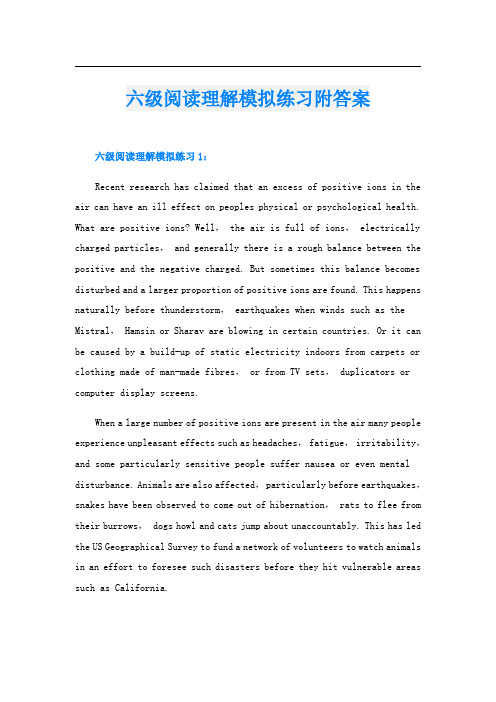
六级阅读理解模拟练习附答案六级阅读理解模拟练习1:Recent research has claimed that an excess of positive ions in the air can have an ill effect on peoples physical or psychological health. What are positive ions? Well, the air is full of ions, electrically charged particles, and generally there is a rough balance between the positive and the negative charged. But sometimes this balance becomes disturbed and a larger proportion of positive ions are found. This happens naturally before thunderstorm, earthquakes when winds such as the Mistral, Hamsin or Sharav are blowing in certain countries. Or it can be caused by a build-up of static electricity indoors from carpets or clothing made of man-made fibres, or from TV sets, duplicators or computer display screens.When a large number of positive ions are present in the air many people experience unpleasant effects such as headaches, fatigue, irritability,and some particularly sensitive people suffer nausea or even mental disturbance. Animals are also affected, particularly before earthquakes,snakes have been observed to come out of hibernation, rats to flee from their burrows, dogs howl and cats jump about unaccountably. This has led the US Geographical Survey to fund a network of volunteers to watch animals in an effort to foresee such disasters before they hit vulnerable areas such as California.Conversely, when large numbers of negative ions are present, then people have a feeling of well-being. Natural conditions that produce these large amounts are near the sea, close to waterfalls or fountains, or in any place where water is sprayed, or forms a spray. This probably accounts for the beneficial effect of a holiday by the sea, or in the mountains with tumbling streams or waterfalls.To increase the supply of negative ions indoors, some scientists recommend the use of ionisers: small portable machines, which generate negative ions. They claim that ionisers not only clean and refresh the air but also improve the health of people sensitive to excess positive ions. Of course, there are the detractors, other scientists, who dismiss such claims and are skeptical about negative/positive ion research. Therefore people can only make up their own minds by observing the effects on themselves, or on others, of a negative rich or poor environment. After all it is debatable whether depending on seismic readings to anticipate earthquakes is more effective than watching the cat.1.What effect does exceeding positive ionization have on some people?A.They think they are insane.B.They feel rather bad-tempered and short-fussed.C.They become violently sick.D.They are too tired to do anything.2.In accordance with the passage, static electricity can be caused by___.ing home-made electrical goods.B.wearing clothes made of natural materials.C.walking on artificial floor coverings.D.copying TV programs on a computer.3.A high negative ion count is likely to be found___.A.near a pound with a water pump.B.close to a slow-flowing river.C.high in some barren mountains.D.by a rotating water sprinkler.4.What kind of machine can generate negative ions indoors?A.Ionisers.B.Air-conditioners.C.Exhaust-fansD.Vacuum pumps.5.Some scientists believe that___.A.watching animals to anticipate earthquakes is more effective than depending on seismography.B.the unusual behavior of animals cannot be trusted.C.neither watching nor using seismographs is reliable.D.earthquake答案:BCDAA六级阅读理解模拟练习2:Once it was possible to define male and female roles easily by the division of labor. Men worked outside the home and earned the income to support their families, while women cooked the meals and took care of the home and the children. These roles were firmly fixed for most people,and there was not much opportunity for women to exchange their roles. But by the middle of this century, mens and womens roles were becoming less firmly fixed.In the 1950s, economic and social success was the goal of the typical American. But in the 1960s a new force developed called the counterculture. The people involved in this movement did not value the middle-class American goals. The counterculture presented men and women with new role choices. Taking more interest in childcare, men began to sharechild-raising tasks with their wives. In fact, some young men and women moved to communal homes or farms where the economic and childcare responsibilities were shared equally by both sexes. In addition, many Americans did not value the traditional male role of soldier. Some young men refused to be drafted as soldiers to fight in the war in Vietnam.In terms of numbers, the counterculture was not a very large group of people. But its influence spread to many parts of American society. Working men of all classes began to change their economic and social patterns. Industrial workers and business executives alike cut down on “overtime” work so that they could spend more leisure time with theirfamilies. Some doctors, lawyers, and teachers turned away from high paying situations to practice their professions in poorer neighborhoods.In the 1970s, the feminist movement, or womens liberation, produced additional economic and social changes. Women of all ages and at all levels of society were entering the work force in greater numbers. Most of them still took traditional womens jobs as public school teaching, nursing,and secretarial work. But some women began to enter traditionally male occupations: police work, banking, dentistry, and construction work. Women were asking for equal work, and equal opportunities for promotion.Today the experts generally agree that important changes are taking place in the roles of men and women. Naturally, there are difficulties in adjusting to these transformations.1.Which of the following best express the main idea of Paragraph 1?A.Women usually worked outside the home for wages.B.Men and womens roles were easily exchanged in the past.C.Mens roles at home were more firmly fixed than womens.D.Men and womens roles were usually quite separated in the past.2.Which sentence best expresses the main idea of Paragraph 2?A.The first sentence.B.The second and the third sentences.C.The fourth sentence.D.The last sentence.3.In the passage the author proposes that the counterculture___.A.destroyed the United States.B.transformed some American values.C.was not important in the United States.D.brought people more leisure time with their families.4.It could be inferred from the passage that___.A.men and women will never share the same goals.B.some men will be willing to exchange their traditional male roles.C.most men will be happy to share some of the household responsibilities with their wives.D.more American households are headed by women than ever before.5.The best title for the passage may be ___.A.Results of Feminist MovementsB.New influence in American LifeC.Counterculture and Its consequenceD.Traditional Division of Male and Female Roles.答案:DCBCB。
英语阅读理解
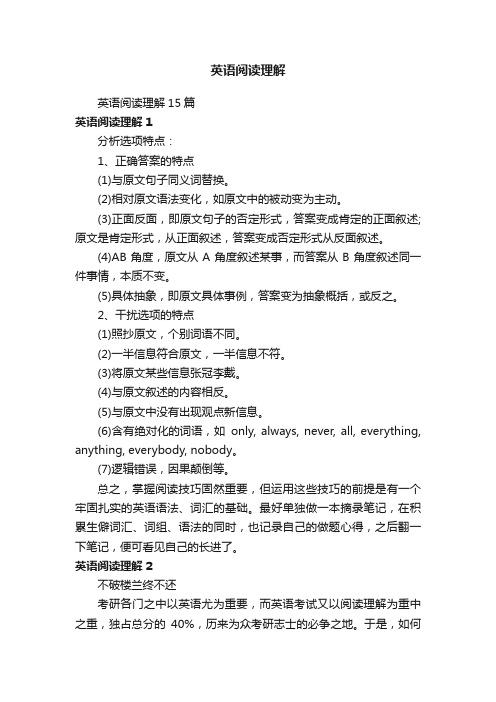
英语阅读理解英语阅读理解15篇英语阅读理解1分析选项特点:1、正确答案的特点(1)与原文句子同义词替换。
(2)相对原文语法变化,如原文中的被动变为主动。
(3)正面反面,即原文句子的否定形式,答案变成肯定的正面叙述;原文是肯定形式,从正面叙述,答案变成否定形式从反面叙述。
(4)AB角度,原文从A角度叙述某事,而答案从B角度叙述同一件事情,本质不变。
(5)具体抽象,即原文具体事例,答案变为抽象概括,或反之。
2、干扰选项的特点(1)照抄原文,个别词语不同。
(2)一半信息符合原文,一半信息不符。
(3)将原文某些信息张冠李戴。
(4)与原文叙述的内容相反。
(5)与原文中没有出现观点新信息。
(6)含有绝对化的词语,如only, always, never, all, everything, anything, everybody, nobody。
(7)逻辑错误,因果颠倒等。
总之,掌握阅读技巧固然重要,但运用这些技巧的前提是有一个牢固扎实的英语语法、词汇的基础。
最好单独做一本摘录笔记,在积累生僻词汇、词组、语法的同时,也记录自己的做题心得,之后翻一下笔记,便可看见自己的长进了。
英语阅读理解2不破楼兰终不还考研各门之中以英语尤为重要,而英语考试又以阅读理解为重中之重,独占总分的40%,历来为众考研志士的必争之地。
于是,如何选择一本高效的阅读理解练习用书自然成为大家议论的焦点。
笔者虽不才,20xx年英语只考了54分,但当时我的四级考试还没过(上一次只考了30多分),要不是在阅读理解上下了些功夫,54分我想都别想。
阅读想要拿高分单词量是基础,没有5300的单词量去做题只能是打击自己的自信心,不要幻想着用作阅读理解的同时记单词来扩大你的单词量,可能你的单词还没有记完,你考研的信心已经被消磨完了。
在背完大纲后,推荐新东方的《英语中高级词汇突破20xx题》,这本书所选的所有句子都来自美国人所写的文章或所出的考题,也就是阅读理解的选材范围,不仅包括大纲的词汇,还有日常报纸、杂志、书籍中常用的单词,其中的试题不是以通常的单选形式出现,而是采用了同、近意替换选择的方式出现,这样做非常锻炼我们灵活应用单词的能力,最后达到记忆单词的目的。
英语短文章【通用10篇】

英语短文章【通用10篇】(经典版)编制人:__________________审核人:__________________审批人:__________________编制单位:__________________编制时间:____年____月____日序言下载提示:该文档是本店铺精心编制而成的,希望大家下载后,能够帮助大家解决实际问题。
文档下载后可定制修改,请根据实际需要进行调整和使用,谢谢!并且,本店铺为大家提供各种类型的经典范文,如工作资料、求职资料、报告大全、方案大全、合同协议、条据文书、教学资料、教案设计、作文大全、其他范文等等,想了解不同范文格式和写法,敬请关注!Download tips: This document is carefully compiled by this editor.I hope that after you download it, it can help you solve practical problems. The document can be customized and modified after downloading, please adjust and use it according to actual needs, thank you!In addition, this shop provides you with various types of classic model essays, such as work materials, job search materials, report encyclopedia, scheme encyclopedia, contract agreements, documents, teaching materials, teaching plan design, composition encyclopedia, other model essays, etc. if you want to understand different model essay formats and writing methods, please pay attention!英语短文章【通用10篇】随着全球化与多元文化的发展,英语正跻身为一种国际语言被广泛使用。
高考英语母题题源系列 专题10 阅读理解(文章结构)(含解析)-人教版高三全册英语试题

母题十阅读理解【母题来源】【2016·】【母题原题】【2016·】DWhy College Is Not HomeThe college years are supposed to be a time for important growth in autonomy(自主性) and the development of adult identity. However, now they are becoming an extended period of adolescence, duri ng which many of today’s students and are not shouldered with adult responsibilities.For previous generations, college was decisive break from parental control; guidance and support needed help from people of the same age and from within. In the past two decades, however, continued connection with and dependence on family, thanks to cellphones, email and social media, have increased significantly. Some parents go so far as to help with coursework. Instead of promoting the idea of college as a passagefrom the shelter of the family to autonomy and adult responsibility, universities have given in to the idea that they should provide the same environment as that of the home.To prepare for increased autonomy and responsibility, college needs to be a time of exp loration and experimentation. This process involves “trying on 〞 new ways of thinking about oneself both intellectually(在思维方面) and personally. While we should provide “safe spaces〞 within colleges, we must also make it safe to express opinions and challenge majority views. Intellectual growth and flexibility are fostered on debate and questioning.Learning to deal with the social world is equally important. Because a college community(群体) differs from the family, many students will struggle to find a senseof belonging. If students rely on administrators to regulate their social behavior and thinking pattern, they are not facing the challenge of finding an identity within a larger and complex community.Moreover, the tendency for universities to monitor and shape student behavior runs up against another characteristic of young adults: the response to being controlled by their elders. If acceptable social behavior is too strictly defined(规定) and controlled, the insensitive or aggressive behavior that administrators are seeking to minimize may actually be encouraged.It is not surprising that young people are likely to burst out, particularly when there are reasons to do so. Our generation once joined hands and stood firm at times of national emergency. What is lacking today is the conflict between adolescent’s desire for autonomy and their understanding of an unsafe world. Therefore, there is the desire for their dorms to be replacement homes and not places to experience intellectual growth.Every college discussion about community values, social climate and behavior should include recognition of the developmental importance of student autonomy and self-regulation, of the necessary tension between safety and self-discovery.67.What’s the author’s attitude toward continued parental guidance to college students?A.SympatheticB.DisapprovingC.SupportiveD.Neutral68.The underlined word “passage〞 in Paragraph 2 means.A.changeB.choiceC.textD.extension69.According to the author,what role should college play?A.to develop a shared identity among studentsB.to define and regulate students’ social behaviorC.To provide a safe world without tension for studentsD.To foster students’ intellectual and personal development70.Which of the following shows the development of ideas in the passage?【答案】67.B68.A69.D70.C68.A猜测词义题。
考研真题范文(通用九篇)

考研真题范文(通用九篇)(经典版)编制人:__________________审核人:__________________审批人:__________________编制单位:__________________编制时间:____年____月____日序言下载提示:该文档是本店铺精心编制而成的,希望大家下载后,能够帮助大家解决实际问题。
文档下载后可定制修改,请根据实际需要进行调整和使用,谢谢!并且,本店铺为大家提供各种类型的经典范文,如工作总结、工作计划、合同协议、条据文书、策划方案、句子大全、作文大全、诗词歌赋、教案资料、其他范文等等,想了解不同范文格式和写法,敬请关注!Download tips: This document is carefully compiled by this editor. I hope that after you download it, it can help you solve practical problems. The document can be customized and modified after downloading, please adjust and use it according to actual needs, thank you!Moreover, our store provides various types of classic sample essays for everyone, such as work summaries, work plans, contract agreements, doctrinal documents, planning plans, complete sentences, complete compositions, poems, songs, teaching materials, and other sample essays. If you want to learn about different sample formats and writing methods, please stay tuned!考研真题范文(通用九篇)考研真题范文(篇一)1、英语前沿报刊2、考研英语复习不同于其他科目,需要考生长期积累。
英语报刊在高中英语阅读教学中的应用

英语报刊在高中英语阅读教学中的应用作者:许广智来源:《校园英语·上旬》2020年第07期【摘要】长期以来,高中英语阅读教学着重于对词汇和语法知识的讲解。
而随着新课程改革的不断深入,对阅读理解和文本写作手法的剖析成为高中英语阅读教学的重要组成部分。
阅读英文报纸能够有效提升学生的英语阅读水平。
基于此,文章探讨了英文报刊阅读在高中英语阅读教学中的应用,并结合高中英语教学实践提出有价值的教学建议,希望能够帮助高中英语教师更好地开展阅读教学。
【关键词】英语报刊;高中英语;英语教学;阅读教学【作者简介】许广智(1980.07.24-),男,汉族,安徽省庐江第三中学,中学二级,本科,研究方向:高中英语教学。
作为学习英语必须掌握的能力,英语阅读能力的培养是高中英语教学的重要组成部分。
新的高中英语课程标准中明确指出英语是一门工具性很强的学科,提倡从三个层面发展学生的英语知识应用能力,通过英语阅读发展学生接收和处理信息的能力就是其中一个层面。
当前阅读类试题在英语考试中仍占有很高的比例,而在实际的高中英语阅读教学中,许多老师都感到非常疲倦,教学效果难以令人满意,主要原因是教师的阅读教学方法不对,忽视了对学生阅读兴趣的激发;在选择英语读物时不注重趣味性,导致学生阅读兴趣不高,学习效果不理想。
一、引导学生阅读报刊猜测词义,积累词汇量词汇学习是英语学习的基础环节。
内容不断更新的英语报刊包含丰富的词汇,教师可以要求学生阅读自己推荐的英语报刊,尝试理解文本含义,结合上下文猜测生词的意义,丰富词汇量,提高英语阅读水平。
在此之前,教师应该先传授学生必要的猜词方法,如联想法、构词法,然后再指导学生运用这些方法猜测报刊中的生词。
为了激发学生的兴趣,高中英语教师可以精选报刊中的精彩文本,要求学生猜词。
例如,She and her family hid away for nearly twenty - five months before they were discovered.”中“discovered”的意思学生都知道,教师可以引导学生思考“cover”的含义。
2021初中英语新课程标准考试模拟试题及答案(三套)
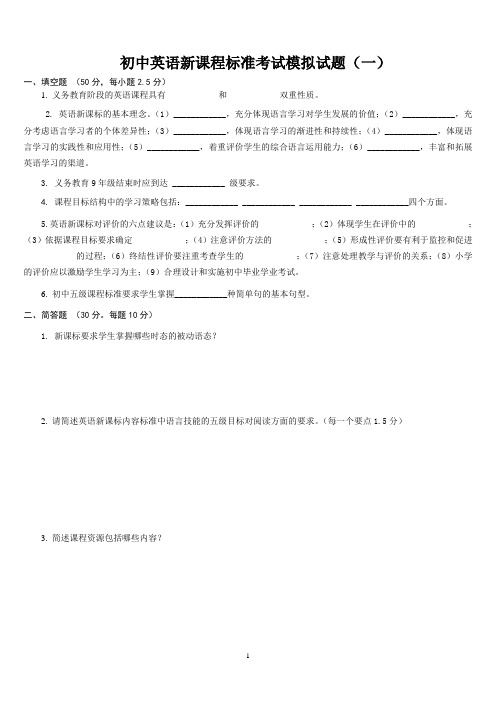
初中英语新课程标准考试模拟试题(一)一、填空题(50分,每小题2.5分)1. 义务教育阶段的英语课程具有____________和____________双重性质。
2. 英语新课标的基本理念。
(1)____________,充分体现语言学习对学生发展的价值;(2)____________,充分考虑语言学习者的个体差异性;(3)____________,体现语言学习的渐进性和持续性;(4)____________,体现语言学习的实践性和应用性;(5)____________,着重评价学生的综合语言运用能力;(6)____________,丰富和拓展英语学习的渠道。
3. 义务教育9年级结束时应到达 ____________ 级要求。
4. 课程目标结构中的学习策略包括:____________ ____________ ____________ ____________四个方面。
5.英语新课标对评价的六点建议是:(1)充分发挥评价的____________;(2)体现学生在评价中的____________;(3)依据课程目标要求确定____________;(4)注意评价方法的____________;(5)形成性评价要有利于监控和促进____________的过程;(6)终结性评价要注重考查学生的____________;(7)注意处理教学与评价的关系;(8)小学的评价应以激励学生学习为主;(9)合理设计和实施初中毕业学业考试。
6. 初中五级课程标准要求学生掌握____________种简单句的基本句型。
二、简答题(30分。
每题10分)1. 新课标要求学生掌握哪些时态的被动语态?2. 请简述英语新课标内容标准中语言技能的五级目标对阅读方面的要求。
(每一个要点1.5分)3. 简述课程资源包括哪些内容?三、论述题(20分)以下是一封信,其中的5个句子被摘出来。
这5个句子打乱顺序后与另外一个多余的句子放在短文后面的方框里。
全国职场英语考试样题
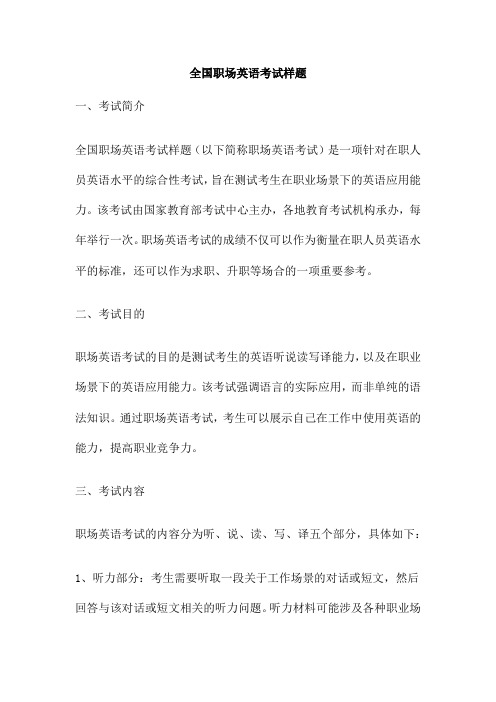
全国职场英语考试样题一、考试简介全国职场英语考试样题(以下简称职场英语考试)是一项针对在职人员英语水平的综合性考试,旨在测试考生在职业场景下的英语应用能力。
该考试由国家教育部考试中心主办,各地教育考试机构承办,每年举行一次。
职场英语考试的成绩不仅可以作为衡量在职人员英语水平的标准,还可以作为求职、升职等场合的一项重要参考。
二、考试目的职场英语考试的目的是测试考生的英语听说读写译能力,以及在职业场景下的英语应用能力。
该考试强调语言的实际应用,而非单纯的语法知识。
通过职场英语考试,考生可以展示自己在工作中使用英语的能力,提高职业竞争力。
三、考试内容职场英语考试的内容分为听、说、读、写、译五个部分,具体如下:1、听力部分:考生需要听取一段关于工作场景的对话或短文,然后回答与该对话或短文相关的听力问题。
听力材料可能涉及各种职业场景,如商务会议、产品介绍、客户服务等。
2、说部分:考生需要完成一项口头表达任务,如模拟商务谈判、产品推介等。
考生需要在规定的时间内准备并进行口头表达。
3、阅读部分:考生需要阅读一篇关于工作场景的短文或信函,然后回答与该短文或信函相关的问题。
短文或信函可能涉及各种职业场景,如商务计划、合同协议等。
4、写作部分:考生需要写一篇关于工作场景的短文或报告,字数一般在150-200字之间。
短文或报告可能涉及各种职业场景,如工作总结、市场分析等。
5、翻译部分:考生需要将一段关于工作场景的英文翻译成中文,或者将一段关于工作场景的中文翻译成英文。
翻译内容可能涉及各种职业场景,如商务邮件、产品说明等。
四、考试形式职场英语考试采用闭卷、笔试的形式进行,总时长为120分钟。
试卷满分为100分,及格分数线为60分。
考试成绩采用分级制,分为A、B、C、D四个等级,其中A级为优秀,B级为良好,C级为及格,D级为不及格。
在商务交际中,以下哪个词表示“业务伙伴”的意思?解释:在商务交际中,“业务伙伴”通常被称为“Colleague”,而其他选项的含义与“业务伙伴”不太相关。
2023全国高考英语甲卷阅读d篇
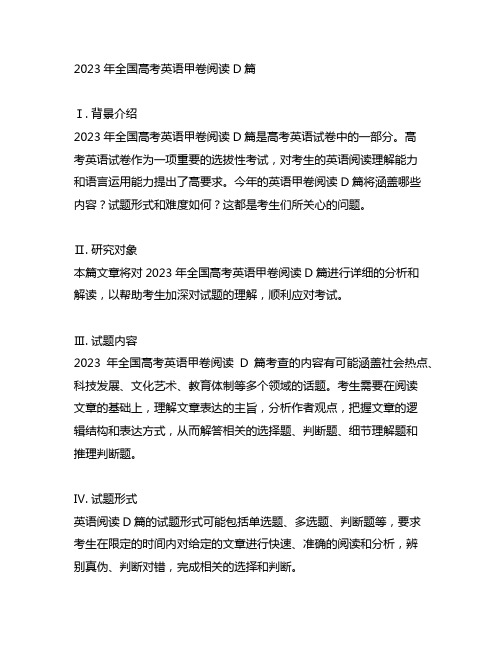
2023年全国高考英语甲卷阅读D篇Ⅰ. 背景介绍2023年全国高考英语甲卷阅读D篇是高考英语试卷中的一部分。
高考英语试卷作为一项重要的选拔性考试,对考生的英语阅读理解能力和语言运用能力提出了高要求。
今年的英语甲卷阅读D篇将涵盖哪些内容?试题形式和难度如何?这都是考生们所关心的问题。
Ⅱ. 研究对象本篇文章将对2023年全国高考英语甲卷阅读D篇进行详细的分析和解读,以帮助考生加深对试题的理解,顺利应对考试。
Ⅲ. 试题内容2023年全国高考英语甲卷阅读D篇考查的内容有可能涵盖社会热点、科技发展、文化艺术、教育体制等多个领域的话题。
考生需要在阅读文章的基础上,理解文章表达的主旨,分析作者观点,把握文章的逻辑结构和表达方式,从而解答相关的选择题、判断题、细节理解题和推理判断题。
Ⅳ. 试题形式英语阅读D篇的试题形式可能包括单选题、多选题、判断题等,要求考生在限定的时间内对给定的文章进行快速、准确的阅读和分析,辨别真伪、判断对错,完成相关的选择和判断。
Ⅴ. 解题技巧1. 仔细阅读题干和选项,理解题目要求,准确把握考点;2. 通读全文,掌握文章大意,理清文章逻辑,找准文章重点和难点;3. 针对每道题目,理清题干所涉及的信息,准确对应文章相关内容,排除干扰选项,找到正确答案;4. 在答题过程中要做到逻辑缜密、思路清晰、表述准确;5. 注意细节,避免因马虎导致失分;6. 时间分配要合理,控制好做题的节奏。
Ⅵ. 备考建议1. 平时多阅读英语报刊杂志,积累阅读理解的能力;2. 熟悉历年的高考英语试题,了解出题规律;3. 练习做一些模拟试题,加强对相关知识点的理解和掌握;4. 多进行语法、词汇和阅读训练,提高语言能力和阅读理解的水平;5. 保持积极的心态,自信,合理安排学习和考试,做到早睡早起,调整好状态。
Ⅶ. 结语2023年全国高考英语甲卷阅读D篇对考生的英语阅读理解能力提出了很高的要求,但只要考生平时多加练习,保持良好的阅读习惯,掌握好解题技巧,相信一定能在高考中取得优异的成绩。
- 1、下载文档前请自行甄别文档内容的完整性,平台不提供额外的编辑、内容补充、找答案等附加服务。
- 2、"仅部分预览"的文档,不可在线预览部分如存在完整性等问题,可反馈申请退款(可完整预览的文档不适用该条件!)。
- 3、如文档侵犯您的权益,请联系客服反馈,我们会尽快为您处理(人工客服工作时间:9:00-18:30)。
英语报刊阅读模拟试题I. Reconstruct the messages of the following headlines of news stories: (10 points)Example: Italian Ex-Mayor Murdered---An Italian Ex-Mayor Is Murdered told not to exploit Tibet issue2.Rubin, Greenspan at odds3.Visitors flocking to Mao’s birth place4.Man quizzed after wife is knifed in sports storeII. Read the following passage and answer the Questions A 5-34 (30 points) and B 35-45 (20 points).Tuition Reform for Higher EducationChinese institutions of higher learning have quickened their pace of reform in recent years. Changing enrollment practices and higher tuition fees constitute and important part of the reform. Schools which once admitted students almost exclusively according to state plans are becoming more accepting of students sent by work groups for further training and those who pay their own fees.Regular universities and colleges plan to enroll about 786 200 students this year, up 158 200 or 25 percent over last year’s figure. Of these, 216 000, or 27.4 percent, will be sent by their work groups or will pay their own way.In the past, the state paid all tuition and school fees for university students, a matter of policy since New China was established in 1949. Although this practice guaranteed the supply of qualified personnel, it brought a heavy burden to the sate, hindering further development of higher education. Since higher education is non—compulsory education in China, to charge appropriate fees will help improve school facilities and expedite the development of education in this stage. As an added benefit, paying their own way will encourage students to study harder.The reform will take effect in two directions. State—financed students will begin paying part of the costs of their education, and more self—paying students will be accepted.In August 1989, under the direction of the State council, the State Education Commission, the Ministry of Finance and the Sate Price Bureau drew up stipulations concerning the amount of charges on tuition, accommodation and other expenses for students of institutions of higher learning. Beginning from that year, freshmen at regular universities and colleges and professional schools (including cadres taking special training courses and students working on a second degree) were charged 100 yuan (about us $17) each for their tuition fee, and this low charge is expected to be raised gradually. The figure was higher in special economic zones and economically developed regions such as Guangdong Province and Shanghai, but was capped at 300 yuan. Students living on campus paid about 20 yuan per year for accommodation and the charge was slightly higher for better furnishing. Normal school students and those admitted on scholarships need only pay for accommodation. Reduced tuitions and fees are available tostudents in need of financial assistance, but accommodation expenses will remain the same.In June 1992, the State Education Commission, the Ministry of Finance and the State Price Bureau decided to allow regular institutions of higher education to set their own tuition rates and charges for accommodation, short—term training programs, correspondence courses and night school. These should be determined according to the needs of each school, the abilities of students to pay and general conditions in each area. The tuition for students in the sciences and engineering can range from 300 to 500 yuan per academic year. Liberal arts, history and economics students of the fine arts pay 400 to 600 yuan per year, and students of the fine arts 400 to 750 yuan. Statistics for 1992 show students paid an average of 340 yuan in tuition that year, only 5 percent of the real cost.Measures have been taken to limit the possible detrimental affects of rising tuition. Shanghai, for instance, exempts the children of revolutionary martyrs from paying tuition. And these costs may be reduced or waived for students with limited family financial support as their parents are either both dead or are receiving subsidies from their work units. Some colleges have also set up work—study programs to benefit students with financial difficultiesGuidelines concerning self—paying students were first set out in 1989. The State Education Commission, the Ministry of Finance and the State Price Bureau stipulated that these students should pay 80 percent of the cost of their education. Such students who live on campus pay the standard rate for accommodation and must cover their own medical expenses. The charge for each self—paying student averaged 2 000 yuan of the cost in 1992, or 30 percent of the cost. Charges for undergraduates and students of special colleges whose education is sponsored by work units, with payment coming either in part or in full from their units, are somewhat higher. Self—paying students are not assigned jobs by the state after graduation, whereas students sent by their units will return to them after graduating.Charges for correspondence courses and night school are equal to or slightly higher than those for full-time students enrolled according to the state plan.With their improvement of their living standards and the deepening of reform, people in general accept the changes in the tuition system. To facilitate the development of higher education, the increases in tuition rates will be more flexible and diversified. Student payments will be augmented by finding from the state, enterprises and funds raised from the public. Laws and regulations will by enacted to ensure steady progress, and overseas organizations and individuals are encouraged to set up and operate schools in China.--21st Century, Apr.20, 1992Reading ComprehensionCircle the letter that best suits the answer or completes the statement.5.Changing enrollment practices and higher tuition fees ____.A.pay an important part in the reformB.make up an important part of the reformC.include an important part of the reformD.hold an important part of the reform6.Regular universities and colleges plan to enroll about 786 200 students this year ____.A.which is the same as last years figureB.which is more than last year’s figure by 158 200C.which is 25 per cent over last year’s figureD.both B and C7.Among 786 200 students ____ will be sent by their work groups or will pay their ownway.A. 158 200B. 21 600C. 27.4 per centD. 25 per cent8.Since New China was established, all tuition and school fees for university students ____A.Were paid by their work groupsB.Were paid by the students themselvesC.Were paid by the stateD.Were paid by the local government9.The policy which the state paid all tuition and school fees for university students ____.A.Brought lots of profits to the stateB.Was helpful to further development of higher educationC.Brought many advantages to the stateD.Brought expense and trouble to the state10.Which statement is not true?A.To charge appropriate fees will help improve school facilities.B.As an added benefit, paying their own way will encourage students to study harder.C.Higher education is compulsory education in China.D.Tuition reform for higher education will take effect in two directions.11.Stipulations concerning the amount of charges on tuition, accommodation and otherexpenses for students of institutions of higher learning was drafted by ____.A.the State Education CommissionB.the State CouncilC.the universities and collegesD.the State Education Commission, the Ministry of Finance and the State Price Bureau12.The figure on tuition fee was higher in special economic zones and economicallydeveloped regions, but was ____.A. fixed at 300 yuanB. limited in 300 yuanC. over 300 yuanD. much more than 300 yuan13.Students in need of financial assistance ____.A.can get a grantB.need only pay for accommodationC.can get support from the local governmentD. can enjoy reduced tuitions and fees14.According to the stipulations made by the State Education Commission, the Ministry ofFinance and the State Price Bureau, the tuition for students in the sciences and engineering can ____.A.be changed between 300 and 500 yuan per academic yearB.be fixed at 300 or 500 yuan per yearC.be set at 400 or 600 yuan per yearD.be extended from 400 to 750 yuan per year15.The children of revolutionary martyrs in Shanghai ___.A.enjoy reduced tuitionB.enjoy free charge tuitionC.gain allowance from governmentD.receive subsidies from their parents’ work units16.Stipulations concerning self—paying students took effect in ____.A. 1989B. 1992C. 1990D. 199117.Charges for undergraduates and students of special colleges whose education issponsored by work units _____.A.are set at 2 000 yuan per yearB.are exempted 50 per cent from the whole cost of their educationC.are rather higherD.are exempted 30 percent18.Self—paying students, after their graduation, ____.A.will return to their unitsB.will be appointed to do some work by the stateC.are provided employments by the statD.are not assigned jobs by the state19.Which statement is true?A.The increases in tuition rates can not be changed easily.B.Students payment will be decreased by funding from the state and enterprises.ws and regulations will be made to ensure steady progress.D.People in general can’t accept the change in the tuition reform.VocabularyChoose the best answer to explain the meaning of the underlined word or phrase.20.Chinese institutions of higher learning have quickened their pace of reform in recent yearA. walkingB. stepC. footD. speed21.Changing enrollment practices and higher tuition fees constitute an important part of thereform.i.Make up B. establish C. hold D. complete22. Although this practice guaranteed the supply of qualified personnel, it brought a heavy burden to the state.A.it brought the state expense and troubleB.it brought the state sufferingC.it made the state involve in difficultiesD.it caused the state involved in troubles23. The reform will take effect in two directions.A. will take placeB. will come into forceC. will affectD. will have an influence24. The figure was higher in special economic zones and economically developed regionssuch as Guangdong, province and Shanghai, but was capped at 300 yuan.A.coveredB. aboutC. overD. much more than25. This Ministry of Finance and the State Price Bureau decided to allow regular institutions ofhigher education to set their own tuition rates and charges for accommodation.A. decideB. fixC. put forwardD. Both A and B26. The tuition for students in the sciences and engineering can range from 300 to 500 yuanper academic year.A.be charged between 300 and 500B.set at 300 or 500C.be decided at 300 or 500D.extend from 300 to 50027. Measures have been taken to limit the possible detrimental affects of rising tuition.A.determinedB. damageC. harmfulD. influential28. Shanghai, for instance, exempts the children of revolutionary martyrs from paying tuition.A.charges a little forB. makes free charge forC. reduces the charge forD. Both A and B29. And these costs may be reduced or waived for students with limited family financialsupport as their parents are either both dead or are receiving subsidies from their work units.insisted on B. not enforced C. charged D. exempted30. Some colleges have also set up work—study programs to benefit students with financialdifficulties.A. helpB. give money toC. give profits toD. send allowance of money to31. The State Educational Commission, the Ministry of Finance and the State Price Bureau stipulated that these students should pay 80 percent of the cost of their education.A.arrangedB. advocatedC. stated clearlyD. stimulated32. Such students who live on campus pay the standard rate for accommodation and must covertheir own medical expenses.A.includeB. exemptC. changeD. provide money for33. Self—paying students are not assigned jobs by the state after graduation, whereas studentssent by their units will return to them after graduation.A.After graduation the state doesn’t give employments to the self—paying studentsB..After graduation, the state doesn’t appoint the self—paying students to do someworkC.After graduation, the self-paying students are not going to apply for jobsD.All are wrong.34. To facilitate the development of higher education, the increases in tuition rates will be moreflexible and diversified.A.will be more easily bent and variousB.will be more limited and variousC.will be easily changed and in variety to adapt to new conditionsD.will be raised more than beforeB Endangered Trade(The Asian Wall Street Journal, Mar., 1999)Such is the special relationship between America and its NATO partners that while that alliance cooperates to bomb Serbian forces, the U.S. and the EU are managing a trade war against each other. Fortunately, no lives are at stake in the latter conflict. Yet if it spreads unchecked, the rest of the world is sure to feel the pain of it.It’s hard to decide whether the U.S. or Europe deserves the most contempt for expanding their trade war. The first fight, over bananas, is essentially a struggle between two fruit distributors with strong political connections. Now Washington and Brussels are escalating their battle over beef, with European farmers stooping to phony science in their claims that hormone-treated American beef is unsafe.In his first term in office, President Bill Clinton teamed up with the Republicans to push major free-trade liberalizations. Now, however, he seems bent on pursuing ‘level even if playing fields,’torpedoing the world economy. The latest salvo was fired this week, with the U.S. announcing it has targeted close to $1 billion of European products for 100% tariffs if the European Union doesn’t drop the hormone nonsense.The move follows an earlier announcement that the U.S. administration will fight Europe’s banana import regime by hitting a range of European goods with prohibitive tariffs. Add to this renewed American threats to raise the drawbridge to Russian, Japanese and Brazilian steel, as well as administration support for a congressional vote to ban Concorde flights from Europe in relation for EU threats to refuse landing rights to old-American planes retrofitted with noise reducing technology.Mr. Clinton sounded the protectionist battle cry in his January State of the Union address, where he vowed to fight for ‘a freer and fairer trading system for 21st century America.’ In the case of agriculture, when the respective lobbies on both sides of the Atlantic enter the fray, that translates into a sticky situation. On the whole, American farmers are major exporters. And U.S. farmers have a good case on beef hormones. But it is nonetheless dangerous for the U.S. to shut off $1 billion in trade.This is not to excuse the EU. The hormone argument is nonsense. The World Trade Organization has acknowledged as much, ordering the EU to allow imports of American meat by May 13. Brussels has responded by saying that it needs more time because European citizens, who supposedly don’t like hormones in their food, would rebel against their governments if American meat suddenly appeared on their store shelves.Were it not for the high stakes involved for both producers and consumers, the argument might be amusing. When governments curtail trade the global economy shrinks and for all the jobs ‘saved’by protections, there are a lot more lost. The Smoot-Hawley agricultural protections imposed by the U.S. Congress in the late 1920s certainly contributed to the Great Depression. Mr. Clinton may believe he is fighting the good fight. But we’ve never thought much of the kind of war where you pose even when you win.Judge whether the following statement are True or False:35. ( ) The Trade war between the U.S. and the EU has cost no lives but is equally dangerous.36. ( ) It’s very easy to decide who is to blame for expanding the trade war.37. ( ) The very beginning of the trade war suggests that it bears political significance.38. ( ) The author agrees that hormone-treated beef is harmful to one’s health.39. ( ) President Bill Clinton used to be a believer of free trade, but not now.40. ( ) Level playing fields ca do good to the world economy.41. ( ) Besides its trade war with the EU, the U.S. is also in conflict with Japan, Russia andBrazil.42 .( ) The author thinks that in the case of beef, the American farmers are justified.43. ( ) The author thinks that it is a right decision for the U.S. to shut off $1 billion in trade.44. ( ) The two sides have submitted the case of beef to the WTO for settlement.III. Read the following passage and answer Questions 45-49 (20 points)The Rich Get Richer and ElectedBy Steven V. RobertsSpecial to The New York TimesWASHINGTON, Sept. 23 –The House of Representatives, which prides itself on being “the people’s House.” Has been turning into a rich man’s club.The representatives newly elected in 1984 were almost four times as wealthy as the first-term lawmakers elected only six years before, according to a new study based one the members’financial reports.Behind this remarkable a swing, the study says, are two main factors: a court decision that outlawed limits on what candidates could give to their own campaigns, and the enormous growth in the cost of pursuing a seat in Congress. As a result, it is increasingly difficult for candidates of modest means, particularly women, to mount successful challenges to entrenched office holders.One solution, the authors contend, is a system of public financing for campaigns, but Congress seems in no mood to change the political rules any time soon.“The lower chamber is going upper class,”said Mark Green, the president of The Democracy Project, a public policy institute based in New York. “But this evolution from a House of Representatives to a House of Lords denies the diversity of our democracy. It establishes a de facto property qualification for office that increasingly says: low and middle income need not apply.”The Democracy Project produced the study in cooperation with the United States Public Interest Research Group, a similar institute situated in Washington. But their research was not entirely theoretical. In 1980 Mr. Green was the unsuccessful Democratic candidate for Congress in New York’s 15th District, in Manhattan. The winner was Bill Green, one of the wealthiest members of Congress.Of Assets and MillionairesMembers of Congress must report their assets in broad categories, not exact numbers, so the figures in the study are not precise. But the minimum average wealth of the 43 lawmakers first elected last year was $251,292. Six years earlier, the 74 new members reported an average of only $41,358 in assets. With inflation figured in, the increase was almost 400 percent in real terms.Moreover, financial data on the class of 1978 indicated only one millionaire, William F. Clinger Jr., a Pennsylvania Republican. Last year’s newcomers included 15 possible millionaires, more than a third of the entire group. Topping the list was Joseph J. Dioguardi, a Westchester Republican, who listed assets of $1 million to $2.46 million.The main reason for the change, Mr. Green maintains, is the Supreme Court decision of 1976 in the case of Buckley V. Valeo. In that case, the Court ruled that limits mandated by Congress on the amount a candidate could give to his or her own campaign were an unconstitutional abridgment of individual rights. At the same time, the Court upheld limits on amounts contributed by outsiders.“Quite naturally”, Mr. Green said, “this puts a premium on personal wealth.The 43 Representatives newly elected in 1984 spent an average of $459,344; of that, $50,329 was their own money in an average case. Eight of the 43 spent more than $100,000 in personal funds but the clear leader was Tommy F. Robinson, an Arkansas Democrat, who contributed $441, 167 to his own campaign. Mr. DioGuardi was next with a personal donation of $210,000.The Senate Puts an even higher premium on wealth. Last year the average candidate for the Senate spent $2 million, and the roster of millionaires in the Senate is steadily growing.The second factor putting a premium on personal wealth, Mr. Green argues, is the rapid rise of political action committees. They tend to favor incumbents with their campaign contributions, and a result, Mr. Green says, is that it takes a wealthy challenger to make a race of things.One apparent effect is the obstacle this poses for women who run for Congress. While women in rapidly rising numbers are capturing local and state offices, their representation on the national level has stayed static. The class of 1984 included only two women: Helen D. Bentley of Maryland and Jan Meyers of Kansas, both Republicans.“It is largely men who control wealth in America,”Mr. Green said, “and if wealth is a major variable in political success, that automatically means more men will run and win.”Fred Wertheimer, president of Common Cause, the public affairs lobby that studies campaign financing issues, summed up the situation this way: “Today, if you’re not personally wealthy, and you’re not willing to indebt yourself to the PAC’s, you face an uphill struggle just to get your message on the table.The authors of the study argue that some form of public financing for campaigns should be instituted. “Competition for public office should be based more upon merit than money,”asserted Gene Karpinski, executive director of the public interest research group.Mr. Wertheimer argues that “members of Congress know they have a national scandal on their hands” and are willing to consider public financing, or at least a total limit on PAC contributions. But the chances for change in the current system remain decidedly poor.Obviously the current occupants of Capitol Hill have kept their seats under the present rules, which clearly favor incumbents. Accordingly, Mr. Green maintains, Congress is still probably “several scandals away” from a serious push to change the campaign system.(From The New York Times, September 24, 1985)45. Why has the House of Representatives been changing into a rich man’s club or a House of Lords?46. In what way did the Court decision favor the wealthy candidates?47. Are women far behind men in getting Congressional offices? Please give an example for your answer.48. What role do political action committees play in a campaign for public office?49. According to the author of the study, on what basis should the political race for public office be placed?V. Translate the following into Chinese: (20%)How to negotiateThe US is an attractive market. Its business culture, which has brought the world “shareholder value”and “IPOs”, has been leading commercial thinking in recent years and will continue to do so. But whoever wants to succeed in the US needs to remember the rules of the game.US business is described by the lyrics of the song New York, New York: “If you can make it here, you can make it anywhere!” Yet a euphoric approach to business is by no means enough. Although business communication in the US is pleasant and easygoing, it is at the same time ruthlessly focused.Communicating is natural talent of Americans. When negotiating partners meet, the emphasis is on small talk and smiling. There is liberal use of a sense of humour that is more direct than it is in the UK. If you give a talk in America, you should speak in a relaxed way and with plenty of jokes to capture your audience’s attention.参考答案I. 补上标题中省略或被代替的单词(每词分1分,共10分)1.The US is told not exploit the Tibet issue2.Rubin and Greenspan are at odds3.Visitors are flocking to Mao’s birth place4. A man is quizzed after his wife is knifed in a sports storeII. 阅读理解A. 每小题1分,共30分5. B6. D7. C8.C9. D 10. C 11. D 12. B 13. D 14. A15. B 16. A 17. C 18. D 19. C 20. D 21.A 22. A 23. B 24. A25. B 26. A 27. C 28. B 29. D 30. A 31. C 32. D 33.B 34. CB.每小题2 分,共20分35. T 36. F 37. T 38. F 39. T40. F 41. T 42. T 43. F 44. TIII. 每小题4分,共20分45.Because the House of Representatives is largely composed of wealthy men, and they getelected not on their merit, but on their money.46. The court decision outlawed limits on the amount that a candidate could give to his own campaign. At the same time it upheld limits on amounts contributed by outsiders.47. Yes. Take the Congressional election in 1984 for example, only two women got elected.48. They play a very important role to help officeholders to get re-elected with campaign contributions.49. Some form of public financing should be taken. Competition for public office should be based more on merit than money.IV. 翻译20 分美国是一个有吸引力的市场。
